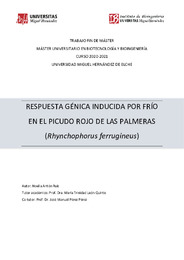Resumen :
El picudo rojo de las palmeras, Rhynchophorus ferrugineus (Coleoptera: Curculionidae) es una de las peores plagas de palmáceas en todo el mundo. Al ser un insecto tropical, su respuesta frente al frío ha sido poco estudiada. Considerando la relevancia que tienen las proteínas de choque térmico (o Hsp) y las acuaporinas en la respuesta frente al estrés térmico, en este trabajo se ha estudiado por primera vez en Rhynchophorus ferrugineus, los niveles de expresión de algunos genes de las familias Hsp60, Hsp70 y Hsp90, así como las acuaporinas PRIP, DRIP, AQP12L y EGLPA2, en respuesta a una disminución brusca y temporal en la temperatura ambiental. El estudio se ha realizado en cuerpo graso y tegumento de larvas prepupa control, tratadas a una temperatura fría (7 días a 5,0 ± 0,5 °C) y sin tratar (7 días a 23 ± 1 °C). Para ello se optimizó la extracción de ARN, se diseñaron cebadores específicos para los genes y finalmente se llevó a cabo la cuantificación mediante PCR cuantitativa en tiempo real. Los resultados indicaron que el procedimiento de extracción de ARN optimizado para Rhynchophorus ferrugineus es válido y puede utilizarse en experimentos futuros tanto en cuerpo graso como tegumento. Además, los cebadores diseñados para los genes Hsp60, Hsp70, DRIP, AQP12L y EGLPA2 parecen funcionar adecuadamente. Los genes Hsp90 y PRIP parecen estar codificando diferentes isoformas de la proteína mediante procesamiento alternativo. A partir de los resultados obtenidos mediante qPCR, se puede concluir lo siguiente: 1) Los genes Hsp60 y Hsp70 parecen expresarse en mayor cantidad en el tejido del tegumento que en cuerpo graso; 2) Los genes Hsp70, AQP12L y DRIP parecen disminuir su expresión en respuesta a estrés por frío en tejido de cuerpo graso; 3) Los genes EGLPA2 y la Hsp60 no parecen variar su expresión tras la exposición a un tratamiento de frío con respecto al control sin tratamiento en Rhynchophorus ferrugineus. Estos resultados iniciales se completarán posteriormente con la finalidad de tener un conocimiento mayor sobre los procesos de daptabilidad en esta plaga para disponer, por tanto, de mejores herramientas para su control.
The red palm weevil, Rhynchophorus ferrugineus (Coleoptera: Curculionidae) is one of the worst pests of palm trees in the world. Being a tropical insect, its response to cold has been little studied. Considering the relevance of heat shock proteins (or Hsp) and aquaporins in the response to heat stress, in this work the expression levels of some genes of the Hsp60 families have been studied for the first time in Rhynchophorus ferrugineus, Hsp70 and Hsp90, as well as the aquaporins PRIP, DRIP, AQP12L and EGLPA2, in response to a sudden and temporary decrease in ambient temperature. The study was carried out on the fat body and integument of control prepupal larvae, treated at a cold temperature (7 days at 5.0 ± 0.5 ° C) and untreated (7 days at 23 ± 1 ° C). In that way, the RNA extraction was optimized, specific primers were designed for the genes and finally the quantification was carried out by means of quantitative PCR in real time. The results indicated that the optimized RNA extraction procedure for Rhynchophorus ferrugineus is valid and can be used in future experiments on both the fat body and the integument. Furthermore, primers designed for the Hsp60, Hsp70, DRIP, AQP12L and EGLPA2 genes appear to work well. The Hsp90 and PRIP genes seem to be encoding different isoforms of the protein by alternative processing. From the results obtained by qPCR, we can be concluded: 1) The Hsp60 and Hsp70 genes seem to be expressed in greater quantity in the integument tissue than in the fat body; 2) The Hsp70, AQP12L and DRIP genes seem to decrease their expression in response to cold stress in fat body tissue; 3) EGLPA2 and Hsp60 genes do not seem to vary their expression after exposure to a cold treatment in contrast with the control without treatment in Rhynchophorus ferrugineus. These initial results will be completed later in order to have a better understanding of the adaptability processes in this pest to have, therefore, better tools for its control.
|
 La licencia se describe como: Atribución-NonComercial-NoDerivada 4.0 Internacional.
La licencia se describe como: Atribución-NonComercial-NoDerivada 4.0 Internacional.
.png)
